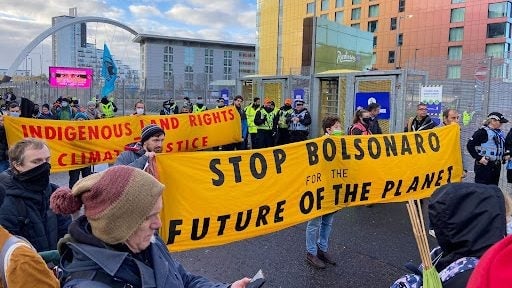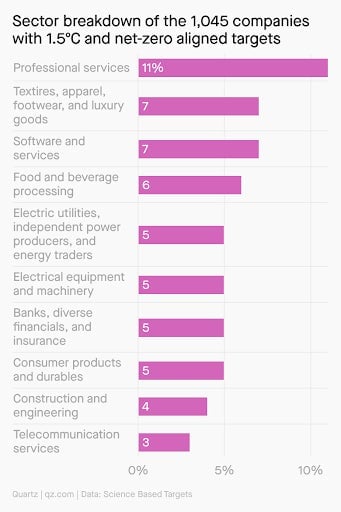Selling the Amazon to save it
Hi Quartz readers,


Hi Quartz readers,
We’re in the home stretch, both for the conference and our coverage. Here’s what we’re watching as we approach the finish line:
- Oil and gas supply cuts: The Beyond Oil and Gas Alliance, an international group to halt new oil and gas drilling led by Costa Rica and Denmark, now has 11 signatories including France, Greenland, Ireland, Quebec, Sweden, and Wales (California and New Zealand will join as associate members).
- Judging the “cover decision”: The latest draft (pdf) of the COP26 final agreement waters down language about a phaseout of fossil fuel subsidies. It now merely “requests,” rather than “urges,” countries to update their climate plans annually. A final draft is expected late Friday or Saturday.
- Fossil fuel data: The Global Registry of Fossil Fuels will be the first comprehensive public database on fossil fuel production and reserves when it launches next year.
- Our readers’ opinions: Take a brief survey to let us know your thoughts on this email.
By the digits
22: Countries planning to make low or zero-carbon shipping a reality via “green corridors”
1: Can of Scottish soda Irn-Bru consumed by US representative Alexandria Ocasio-Cortez, causing the bright orange drink to trend on Twitter
70: Number of protesters arrested by Glasgow police during COP26
262 million metric tons (289 million tons): Emissions that could be cut by 2030 if the 100 highest emitters in the Science Based Targets Initiative follow through with their promises (pdf)
1:55pm: Local time on Sunday at which the longest COP, COP25 in Madrid, ended in 2019
Could we pay farmers not to cut down the Amazon?

André Guimarães has a dream to put the Amazon up for sale—at least, the rainforest’s incredible carbon-storing capacity. Guimarães is the executive director of the Amazon Environmental Research Institute, a Brasilia-based nonprofit. He spent the summit talking with researchers, activists, and businesspeople at the Brazilian civil society groups’ green-and-yellow pavilion about his dream of paying farmers to keep the Amazon intact.
“It’s intellectually and physically intense,” he said. “But this is a moment where you can see some of your dreams potentially coming true.”
While 90% of deforestation in the Amazon is illegal (thus a job for law enforcement), an area about the size of Honduras can be deforested legally because it is privately owned farmland.
Guimarães wants carbon markets to finance a new program paying farmers not to cut down their trees.
Today, those payments of $160 per acre—covering almost 25,000 acres—are financed by donations from European governments. But within the next two years, Guimarães hopes, capital from the global carbon market will begin flowing to Brazil in earnest. Private companies with net-zero emissions targets will be able to pay to protect the country’s threatened forests.
The approach isn’t perfect, Guimarães admits. It requires rigorous monitoring, and doesn’t solve the issue of how to incentivize farmers to protect their land permanently (essential if offset purchasers wish to avoid greenwashing). And while farmers know the daily price for soybeans, it’s harder to follow carbon markets and know if they’re getting a good deal for their land.
At COP26, Brazil’s government pushed to water down carbon market rules that could make programs like these credible. With deforestation in the Amazon at an all-time high, Brazil was one of the only countries to weaken its climate goals compared to earlier targets.
Historically, Guimarães said, Brazil served a more productive role in climate diplomacy. “But to do that, you have to have a good reputation, and Brazil has lost much of that because of deforestation,” he said. “It’s a pity, and a true loss for the entire debate.”
Corporations pledge to do their part
The Science Based Targets Initiative announced 1,045 companies have pledged to 1.5ºC and net-zero aligned targets, nearly double the number of committed companies in April, including Procter & Gamble, Ralph Lauren, Unilever, and Walmart.

QZ&A: Nigel Topping at COP26
We caught up with Nigel Topping, the UK’s “high-level climate action champion” working with business and former director of the Carbon Disclosure Project, on the conference floor at COP26.
The fundamental goal of this COP was to “keep 1.5 alive.” Did we?
1.5 is still alive if we don’t rest on our laurels and just see how things go for four years. Anyone who doesn’t update their plans every year or two at the most is going to wake up and be really behind the race. But we’re seeing exponential change in sector after sector.
Finance for climate adaptation is still falling far short. Why is it so hard to close that gap?
One reason is that far too many conversations are based on the idea that this is a zero-sum game. The difference between a 1.5°C trajectory and the current one is something like $15 trillion of economic activity every year. We need to see it’s a non-zero-sum game, and that climate finance will raise all boats.
What does accountability look like for companies that have set voluntary net-zero commitments—the difference between real action and, as Greta Thunberg puts it, “blah blah blah”?
If you’re a listed company and you haven’t started thinking about a transition plan that you’re prepared to share with your staff, your customers, your investors, they will hold you accountable and vote with their feet or their dollars. The whole system is orienting around the same goal.
“Blah blah blah” means bullshit, and there’s bullshit everywhere, people making overinflated claims of action or inaction. The first thing we need to do is talk facts. Increasingly we’ll see COP reviewing, “OK, what have you done in the last year?” We don’t need to wait five years to see if shovels are in the ground. Show us the evidence, and tell us what you’ll do next.
Cities are at the forefront of the ongoing climate crisis. Our member-exclusive weekly Forecast email recently took a look at how they’re preparing for more extreme weather. Get 40% off a Quartz membership with code COP26.
👀 what’s next
⁉️ The overarching goal of COP26 was to “keep 1.5°C alive,” referring to the global warming limit the Paris Agreement aspires to. Was it a success? At the time we’re writing this email, there’s no way to say. Despite assurances from organizers that the summit will wrap up by Friday night, no one in Glasgow expects to see a resolution before the weekend (the last five COPs have all ended on Sunday).
Many crucial decisions—particularly on carbon markets and on the core agreement text—remain undecided. Now it’s up to ministers to close a deal that opens the door for more climate finance and commits countries to up their ambitions. “The lives of everyone in the world depend on actions taken in the next few hours,” Gabriela Bucher, executive director of Oxfam International, said in a heated press conference late Friday afternoon.
Stay tuned Monday for a wrap-up of the final agreement.
One ⚖️🚨 thing
Youth climate activists filed a legal petition to the UN secretary-general, urging him to declare a “system-wide climate emergency.” The group of 14, which includes Greta Thunberg, called on António Guterres to use emergency powers to declare the climate crisis a global level three emergency, the UN’s highest category and the same classification given to the covid-19 pandemic.

Keep learning
- No one knows how $80 billion in climate financing was spent in 2019
- An old friendship is behind the surprise US-China COP26 announcement
- Can Egypt, host of next year’s COP27, break its gas addiction?
- Fossil fuels have been targeted at a global climate summit for the first time
- What is climate justice?
- Africa’s first “chief heat officer” says Freetown could be a data-driven climate model
Our best wishes for a net-zero day. Get in touch with us at [email protected] and live your best Quartz life by downloading our iOS app and becoming a member. Today’s email was brought to you by Tim McDonnell, Amanda Shendruk, Michael Coren, and Liz Webber.